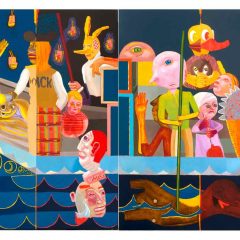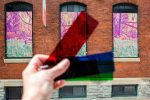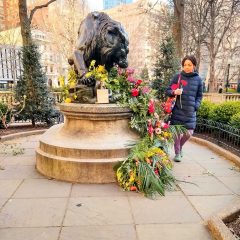—>Mei-ling Hom and David McClelland report on a project they did in New Orleans this Winter. David and Mei-ling, former Philadephias and friends of Artblog, now live on their working farm in upstate New York. This new project of theirs creates some whimsy in the Post-Katrina landscape, but adds a layer of hope — that art in community agriculture can produce magic results.–the Artblog editors—>
Post by Mei-ling Hom and David McClelland
The Joan Mitchell Center is currently in the process of establishing an arts center in New Orleans in a grand 19th century house half way between the French Quarter and the New Orleans Art Museum. The two acre property, which was formerly a bed and breakfast known as “The House on Bayou Road,” is undergoing extensive renovation, which involves moving dozens of mature trees and shrubs so that a modern art studio can be built.
Residency at the Joan Mitchell Center in New Orleans
The first group of artists in residence chosen from previous Joan Mitchell grant recipients are willing participants in a pilot program to iron out the kinks in an evolving residency program designed to encourage interaction between New Orleans art and social organizations and the visiting artists. We recently motored down the Natchez Trace to Louisiana to experiment with our mix of farming and art that we call the “Intersection of the Visual and the Edible.”
Mushrooms and art – the back story and the show in Cincinnati
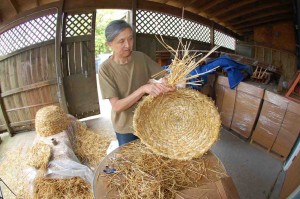
Since attending Cornell University’s Mushroom Camp in the snowy depths of April 2011, we have been integrating mushrooms into both our farmscape in western New York and into discrete straw sculptures which Mei-ling has designed and woven. The first of these sculptures was dispatched to Sue Spaid’s curated exhibition, Green Acres: Artists Farming Fields, Greenhouses and Abandoned Lots in Cincinnati at the Contemporary Art Center.
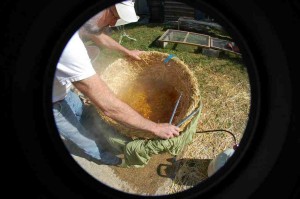
For the Cincinnati exhibition mushroom spores integrated into the straw filling of the sculpture were in their dry dormant stage in order not to grow until the museum conservators water the piece which would endanger all the other artworks in the museum which aren’t stainless steel or stone. Maybe at the end of the touring exhibition the mushroom sculpture can be moved outside and left to grow and flourish naturally.
When the oyster mushroom spores or spawn are given the right mix of temperature and humidity they will grow in the sculptures and in the end will consume them leaving behind a rich soil amendment.
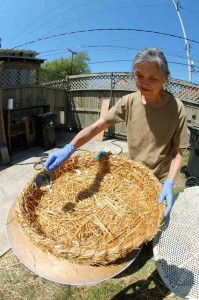
So the plan is really threefold: We create straw sculptures which are visually pleasing and inoculate them with mushroom spawn which give us a harvest of edible salable mushrooms and the end product is a nutrient-rich humus which will benefit the next crop of green plants.
The big news about oyster mushrooms – they are predators
But that isn’t all, oyster mushrooms are carnivorous! Their roots grow tiny lassos about three cells in diameter and they secrete chemical signals which attract nematodes, microscopic wormlike creatures which slither through the soil. When the unsuspecting nematodes stick their front ends (they don’t really have heads) into the loops, the oyster mushroom mycelia tightens on them and then digests them. Since some nematode species attack plant roots, having a nematode predator sited in your garden may be beneficial. An additional benefit to growing oyster mushrooms is that their mycelia or roots will also dismantle hydrogen carbon chains which means that they digest oil spills!
The New Orleans project at Grow Dat Youth Farm
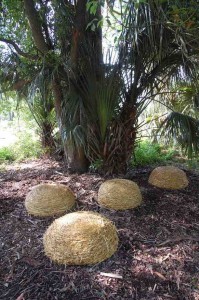
With all these benefits in mind and a vision of improving New Orleans‘ cityscape we sought out the Grow Dat Youth Farm, an organization headquartered in City Park up the road from the New Orleans Art Museum. Grow Dat is committed to mentoring high school students using agriculture as a medium to explore teamwork and self development. After we had perfected our method of coiling straw ropes, lashing these ropes together into three dimensional forms, and pasteurizing the straw forms in 160 degree water (unpleasantly warm when poured on a sandal clad foot) we gave a workshop for the urban farming public next to a scenic bayou alongside the Grow Dat Farm.
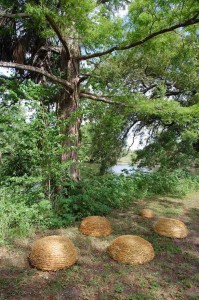
By the end of our stay in New Orleans four large straw Mushroom Bumps were sited on a rich bed of woodchips in City Park and two smaller straw sculptures slipped into the secret garden section of New Orleans’ famous Longvue Gardens, a mansion and formal garden reminiscent of Longwood Gardens, the Dupont estate near Philadelphia. When we left New Orleans in a semitropical downpour, the Mushroom Bump sculptures were much as we had made them with only the white cottony hint of mycelia (mushroom roots) on their undersides to reassure us that they were alive and well.
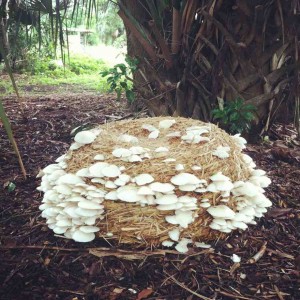
An excited email followed us north with a photo of one Mushroom Bump completely wreathed with fruiting oyster mushrooms.
We plan to continue the project this Fall and next Spring at the Bernheim Arboretum and Research Forest in Clermont, Kentucky. Bernheim has a wonderful blend of public art and public science with an emphasis on restoring the landscape of central Kentucky and making it available to the public for recreational use. Since the forest is located in the heart of the bourbon distilling region we are turning our research to ways to use the spent distillers mash in fungi sculpture.
Mei-ling Hom and David McClelland are farmers and artists who spend the growing season in Andover, New York and then return to Philadelphia when the ground freezes and deer season starts. Opportunities to work in other environments have taken them to New Mexico, New Orleans, and various locales in Asia.
Read Mei-Ling and David’s 2009 posts from Thailand and Singapore.


